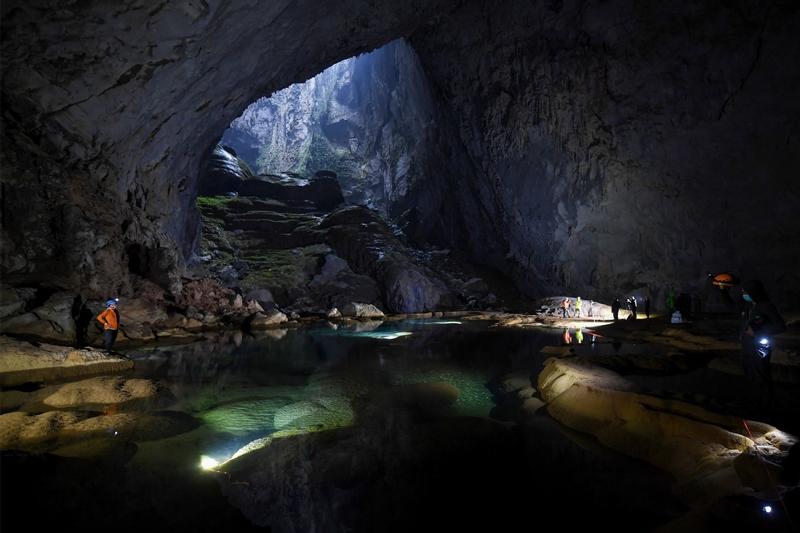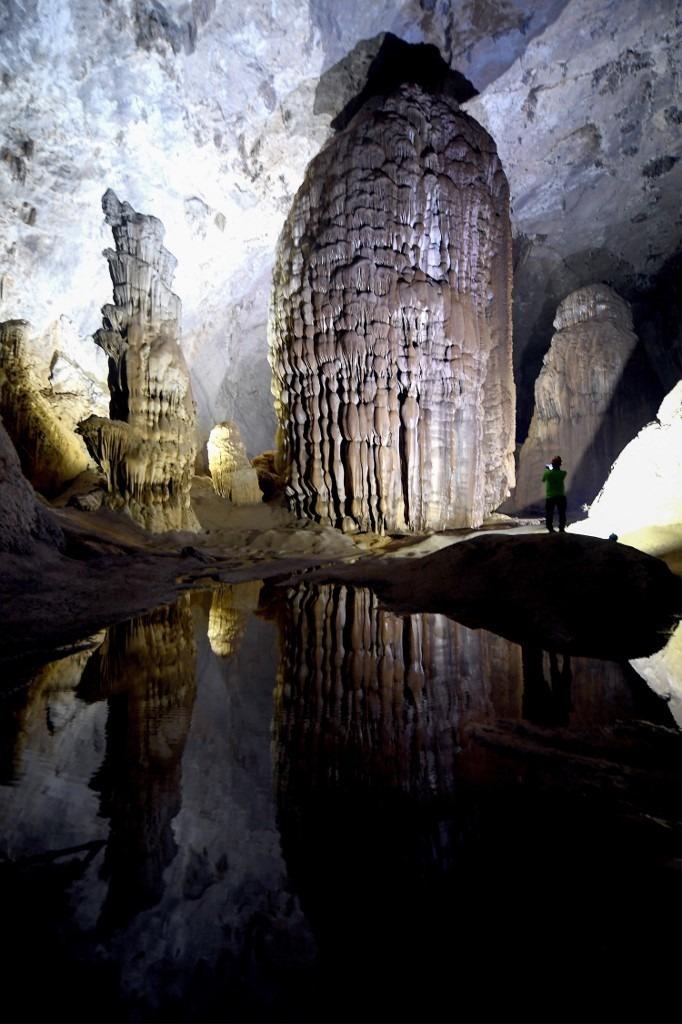 Tourists visit Vietnam's Son Doong cave, the world's largest natural cave system, in Quang Binh province, Jan 18, 2021. (NHAC NGUYEN / AFP)
Tourists visit Vietnam's Son Doong cave, the world's largest natural cave system, in Quang Binh province, Jan 18, 2021. (NHAC NGUYEN / AFP)
PHONG NHA-Vast rock formations the size of multistory buildings loom above Ho Minh Phuc, as he picks a path through the gloom inside the world's largest cave.
Phuc, who once earned a living through illegal logging, is a porter for the small tour groups that explore Vietnam's Son Doong-a cave so large it has its own ecosystem and weather patterns.
Home to flying foxes and a 70-meter rock formation resembling a dog's paw, the cave is an otherworldly wonder that has reshaped the lives of the surrounding community since it opened for boutique tourism in 2013
Home to flying foxes and a 70-meter rock formation resembling a dog's paw, the cave is an otherworldly wonder that has reshaped the lives of the surrounding community since it opened for boutique tourism in 2013.
ALSO READ: Vietnam's tourism resources under threat
Trapped in poverty, young men like Phuc once had little choice but to forage in the depths of Phong Nha-Ke Bang National Park-the World Heritage site where Son Doong lies.
There they searched for precious agarwood, a hugely sought-after material known as "the wood of the gods" and widely used for incense.
Others eked out a living from hunting civets and porcupines in the forest.
"We had to do all we could to avoid the forest rangers," 35-year-old Phuc said. "We did nothing good for nature."
Son Doong in central Quang Binh Province was first discovered by local forager Ho Khanh in 1991, when he stumbled upon an opening in a limestone cliff and heard the sounds of a river deep inside.
But after returning home through the thick surrounding jungle, Khanh forgot where the hidden entrance lay, and it stayed lost for another two decades.
When he eventually led a team of British experts back there in 2009, the team found it had the largest cross-section of any cave anywhere on the planet.
 A visitor takes photos of the rock formations inside Son Doong cave during a tour in central Vietnam's Quang Binh province, Jan 16, 2021. (NHAC NGUYEN / AFP)
A visitor takes photos of the rock formations inside Son Doong cave during a tour in central Vietnam's Quang Binh province, Jan 16, 2021. (NHAC NGUYEN / AFP)
It is large enough to house the 40-floor skyscrapers of an entire New York City block, according to adventure tour company Oxalis, which guides visitors into the caves.
When Son Doong was opened to tourists four years later, the lives of Khanh and hundreds of locals changed forever.
New porters, guides
They soon became porters and guides and opened their homes to guests wanting a bed for the night.
"Some became rich with logging, but most lived a very hard life," Khanh, now 52, said of the time before the cave was opened to the outside world.
"When tour companies came in, I told the youngsters their first duty was to protect the environment so as to benefit not just ourselves but also our children, ... so life can improve."
READ MORE: The picture of patience
 This photo taken on Jan 16, 2021 shows visitors inside Son Doong cave during a tour in central Vietnam's Quang Binh province. (NHAC NGUYEN / AFP)
This photo taken on Jan 16, 2021 shows visitors inside Son Doong cave during a tour in central Vietnam's Quang Binh province. (NHAC NGUYEN / AFP)
As COVID-19 swept the globe, locals catering to travelers have struggled. Khanh says his guest numbers are 90 percent down since the pandemic began.
But Son Doong has weathered the crisis fairly well overall, thanks to a boost in visitors among Vietnam's fast-growing middle class.
The high-end tourism model of the caves-which provides around 500 jobs for the local community-has begun to attract interest in other areas, Oxalis said.


